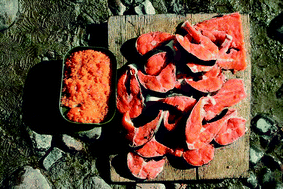There are strong indications that a moderate intake of fatty fish decreases the risk of cardiovascular diseases due to its content of omega-3 fatty acids. Other studies indicate that fatty fish consumption increase the body burden of Persistent Organic Pollutants (POPs) and may thereby increase the risk of negative health effects. Many of the latter studies are based on POP analysis of fatty fish, from which a recommended daily intake for humans has been calculated based on the no-observed adverse effect level (NOAEL) obtained from animal studies. Studies investigating associations between human plasma concentrations of POPs and intake of marine food show deviating results. In this study we investigated associations between self-reported intake of marine food (fatty fish, fish liver, fish liver oil, seagull eggs and halibut) and plasma concentrations of POPs. The study group consisted of 44 women and 16 men from northern Norway with a marine based diet. In addition to donate blood samples, the participants answered a detailed food frequency questionnaire with special emphasis on marine food consumption. Concentrations of 25 different POPs were measured in plasma. PCB 153 and p′p-DDE were the most ubiquitous PCB and chlorinated pesticide and the geometric mean concentrations were 73 ng/g lipids and 116 ng/g lipids respectively. The main findings in this study were that age, gender and intake of fresh fish liver oil were significant predictors of three of the most common PCBs and trans-Nonachlor in this study group. In addition, intake of seagull eggs influenced the concentration of PCB 180. However, even though the participants had a high intake of marine food they did not have elevated levels of POPs compared to other study groups. Intake of fatty fish did not significantly affect the body burden of POPs in this study group.

You have access to this article
 Please wait while we load your content...
Something went wrong. Try again?
Please wait while we load your content...
Something went wrong. Try again?


 Please wait while we load your content...
Please wait while we load your content...